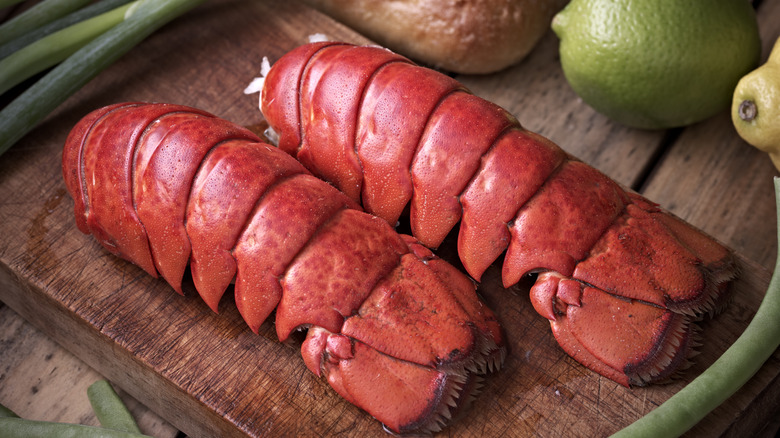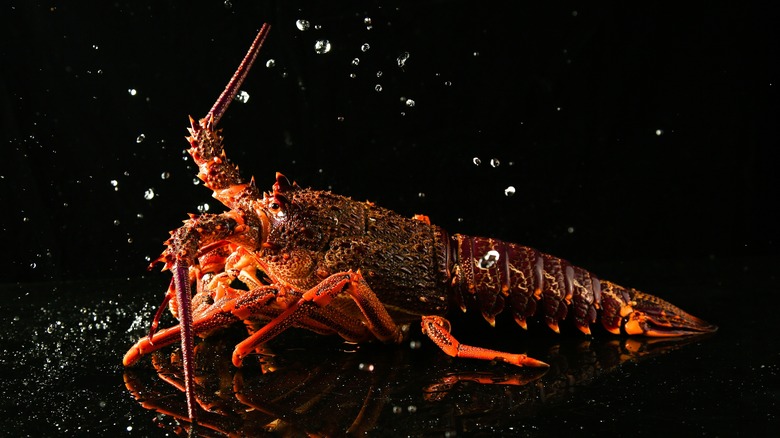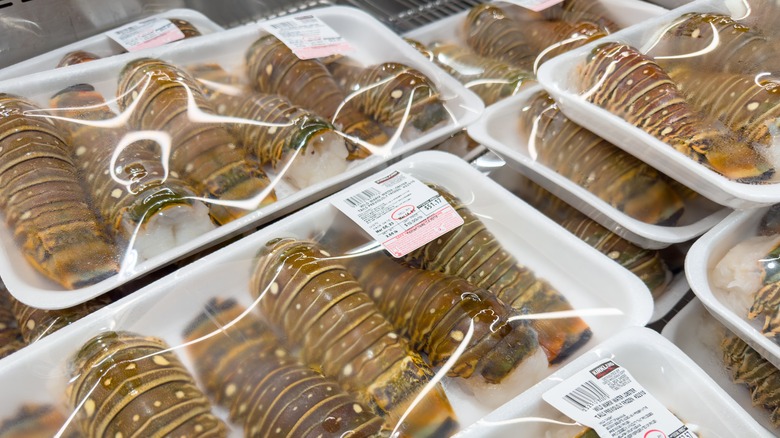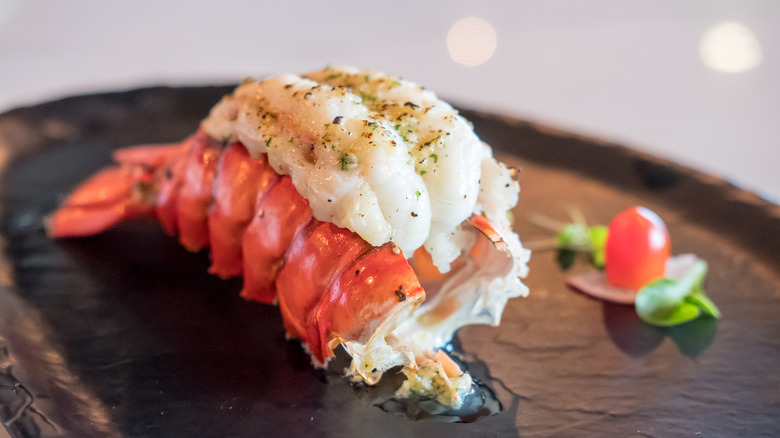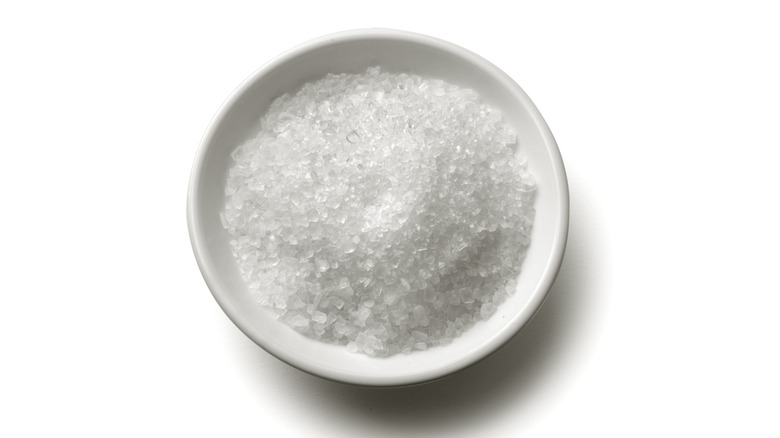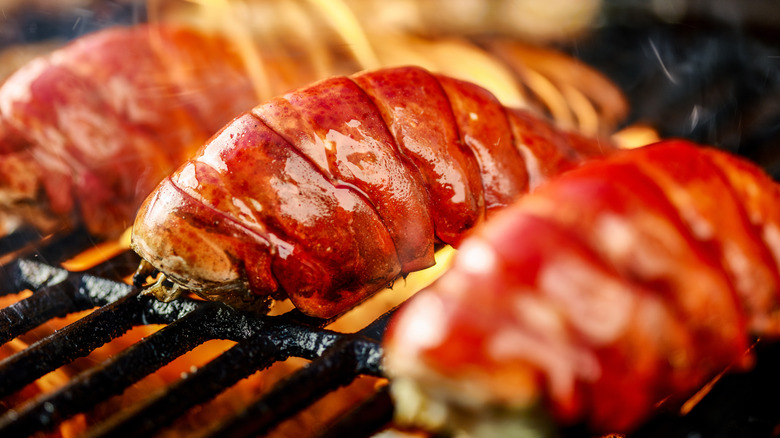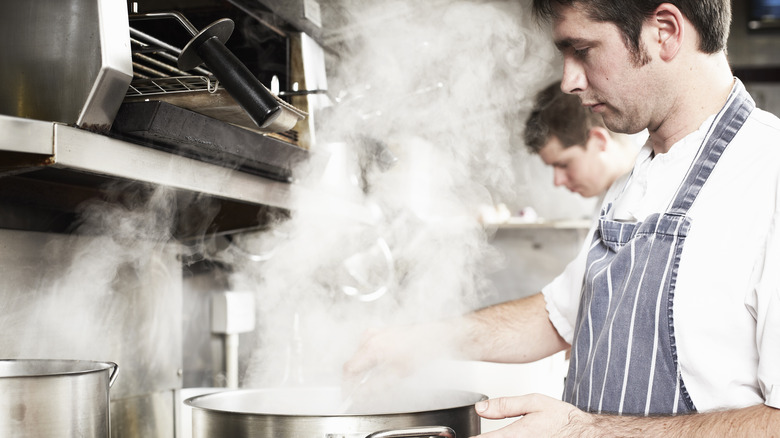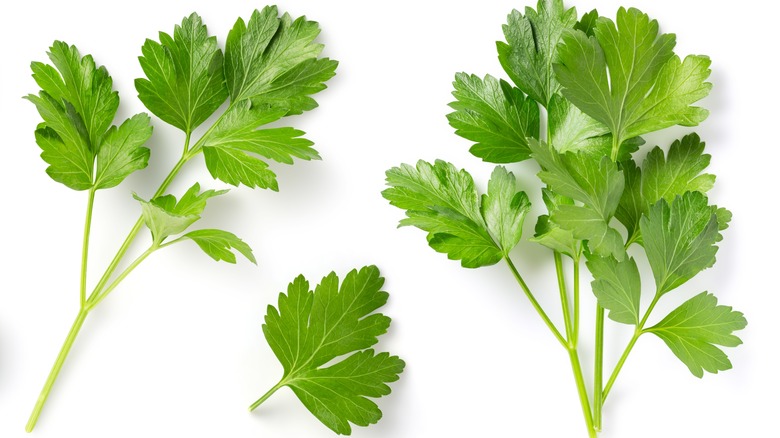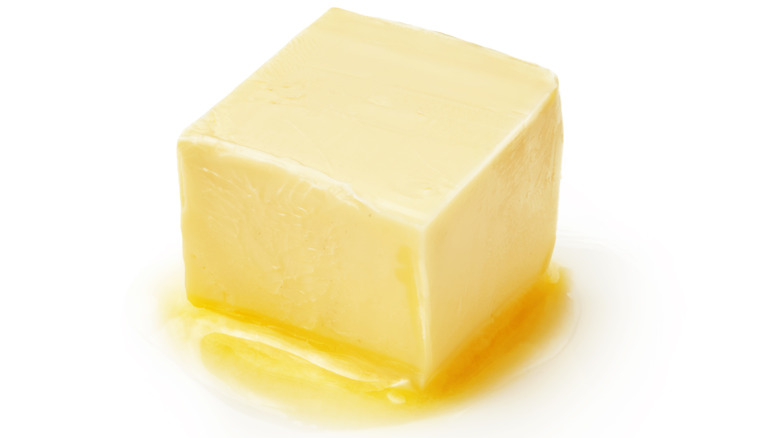8 Tips For Cooking Lobster Tails To Perfection
Lobster has an origin story like few other luxurious food items. In the early days of colonial America, many people considered it food for the poor and imprisoned. Sometimes, lobster was even called the cockroach of the sea. But in the early and mid-1900s, cooks discovered many things about lobster, including that they're best when cooked fresh and alive. It began appearing on high-end restaurant menus as a luxury item. By the time I started cooking in fine dining restaurants in the late 1980s, lobster was the pinnacle of fanciness (along with caviar and champagne). Consequently, I've probably spent a full calendar year of work time prepping and cooking lobster — both the Maine variety and the spiny types.
Lobster tails are versatile when it comes to cooking method: Poaching, grilling, steaming, and boiling are all common approaches. But the meat is delicate, and while the cooking methods are straightforward, there are ways for them to go sideways, leaving you with stringy, dry lobster meat. Lobster isn't inexpensive, so avoiding these pitfalls is crucial to protecting your investment. Here, we'll examine the entire process, from identifying and picking your lobster to executing the most popular cooking methods, to ensure you're cooking your lobster tails to perfection.
Know what type of lobster you're buying
While there are multiple types of lobster, the two you'll most frequently encounter are the spiny lobster and the Maine lobster. Each type has cousins around the world. Their claw ownership is the biggest differentiator between the two. The Maine lobster, or Homarus americanus, is the popular, brightly-colored (when cooked) lobster that has become the de facto image of lobster in the public consciousness. This species is found from Canada to the Carolinas, with the highest populations along the coast of Maine. The rule of thumb with these lobsters is the colder the water, the sweeter the meat. They carry less meat in their tails than spiny lobsters, but make up for it in claw and body meat.
Spiny lobsters live in every ocean in the world. Names under the spiny lobster umbrella include langoustine, rock lobster, and Dublin Bay prawn. Many diners say the spiny varieties aren't as rich in flavor as the Maine lobster, because so many live in warmer waters. Their tails are significantly larger than the Maine species, and their either non-existent or inconsequential claws don't contribute any worthwhile food, so they're typically harvested for their tails only.
You can cook each type of lobster using the methods we'll discuss. Take note, though, that you might sometimes find Maine lobsters in the soft-shell variety. These soft-shell lobsters require gentler cooking methods, so avoid grilling or roasting them in the shell.
Start with a good tail
The first rule of buying fresh lobster is to pick the proper size. For Maine lobsters, which are sold whole and can run as high as 45 pounds, a 1 and ¼ to 2 pound lobster is a good portion for each person. These lobsters will yield enough meat to satisfy, but won't be so large that uneven cooking is a problem. For spiny lobsters, you'll typically find just the tail, which yields more meat per person; 6 to 8 ounces is a good choice.
Typically, you'll find Maine lobsters packed and shipped live. When picking one, always look for signs of life, as dead lobsters aren't for eating. Frequently, the lobsters become lethargic when packed for shipping or put on ice, so don't expect them to jump around, but do look for slow, steady movement of their extremities. Buy live lobsters the day you expect to cook them, as they can expire in your refrigerator and become unusable.
You'll also find frozen Maine and spiny lobsters, although spiny is more common. Fresh isn't always best, and these lobsters are flash-frozen soon after harvest. With frozen, you won't risk your lobsters dying, and the flash-freezing process preserves their quality. Pass up any with crystalized ice, though, as it's a sign they've thawed and refrozen. You should also consider its harvest location and catch method. Seafood Watch has listed Maine lobster in the "Avoid" category due to population concerns and effects on other marine species.
Know what over or undercooked lobster looks like
Before cooking your lobster tails, you must know the two biggest pitfalls of the process: over or under-cooking them. Undercooking is the easiest of the two to diagnose. The first semi-reliable indicator of doneness is the color of the lobster's shell. The lobster doesn't come out of the water with the bright orange-red color you see on the table. Instead, the shell has shades of brown, green, blue, and yellow. If the shell shows any of these colors, even if it's also showing orange in spots, your lobster is undercooked.
But don't assume lobster is cooked just because it's changed color. Lobsters have a pigment in the membrane under their shells that heat releases, and when exposed to blue light, it turns orange. This color change happens quickly, which doesn't correlate to the time it takes for the lobster to cook. Given that color isn't a reliable indicator, it's easy to assume a longer cooking time is critical, but many people go overboard with that idea. Unfortunately, many recipes also have conflicting cooking times. Time is a poor indicator of doneness because too many variables are in play. Luckily, when cooking lobster tails, there is a key sign of doneness you can look for in the joint where the tail meets the body. The most reliable indicator is a probe thermometer stuck into the center of this meat, which should read 135 to 140 degrees Fahrenheit.
Boil lobster with plenty of salt
A common misconception that leads to lousy lobster tails — or that of any crustacean — is that if these shellfish come from salt water, they're already salty. But in fact, when you read flavor descriptions of lobster meat, you'll find "sweet" and "rich" used, but rarely "salty." That should be an indicator that some further seasoning is in order.
The most straightforward means of cooking lobster tails is boiling. Simply heat a pot of water and add your tails. But this is your one and only opportunity to add flavor to the lobster meat, so don't squander it. Any seasoning or flavoring added later will affect the lobster tail's surface, not the whole tail. About 3 to 4 tablespoons of salt per gallon of water is enough to bring your cooking water to ocean-like salinity levels, which is exactly what you want. The salt will permeate the meat without over-salting it, enhancing the flavor and making it taste more, well, lobster-y.
Boiling is an easy, no-muss-no-fuss preparation for both raw and pre-cooked lobster tails, but be aware that cooking times vary between the two. You're simply reheating a pre-cooked tail, versus cooking a raw one. As such, the cooking time is drastically shorter for pre-cooked tails. Roughly 2 to 3 minutes should be sufficient for reheating pre-cooked tails, while 4 to 5 should cook your raw tails through. As always, a probe thermometer is your best indicator of doneness, with a target temperature of 135 to 140 degrees Fahrenheit.
Grill them in the shell
Despite a lobster's armor-like exterior, their meat is delicate, even in the muscular tail. Grilling is an excellent preparation for lobster, but you must protect the fragile flesh from the fire for the best results. The shell provides a protective layer between the grill grates and the meat, so keep it in place while grilling.
Before you grill your lobster tails, let them warm up at room temperature. Then, set your grill up for two-zone cooking — one hot area and another medium-heat zone. Start grilling your lobster tail over high heat until the shells turn orange-red. Move the tails to the cooler zone before any significant grill marks develop, as you don't want to overheat or burn the shell. Localized heat while creating the grill marks can lead to overcooked spots where the shell is hotter. You also want to avoid scorching the shells, as the burnt smell — similar to charred bone — can permeate the meat, making your high-dollar investment unpalatable.
An adjacent approach yields even better results. Poaching the lobster tails until just underdone in a root vegetable and aromatic-scented broth infuses the lobster meat with flavor. You can then move the poached tails directly to the lower-heat section of your grill to allow them to finish cooking while taking on grilled flavor. This extra step makes them more delicious and minimizes the time the tails spend over the flame, taking overcooked spots and charred shells out of the equation.
Add flavoring to your steam
Steaming lobster tails is slightly more complicated than boiling, but it's gentler than exposing them to rapidly boiling water. Steam isn't necessarily hotter than boiling water, but it contains more energy than water does. This means it contains more heat, even at the same temperature as boiling water. To steam, you need a heat source and a moisture source. The heat could be indirect, like boiling water, or direct, like from a grill or coals. The moisture could come from boiling liquid, or you could wrap the lobster tails in seaweed or wet cloth that steams as its moisture evaporates. Whether using liquid or a wrap, don't miss the opportunity to infuse the lobster tails with flavor.
You can make a fragrant broth of carrots, onions, and celery, then flavor it with aromatic herbs, citrus, stone fruit, or apples. You can also forgo the water altogether and steam your lobster tails in beer or wine as your liquid, with whatever added aromatics and flavoring you choose. If you decide to wrap your lobster tails, you can also add flavors. Seaweed adds its own natural taste and salinity to the steam, and plays well with lemongrass, ginger, lavender, tarragon, or other strongly scented aromatic herbs. Place the wrapped tails on the grill or directly onto coals to absorb their smoky flavor.
Use plenty of butter and herbs for sous vide
Cooking lobster tails sous vide offers an opportunity for exceptionally tender, flavor-infused meat. However, the spiky shells are challenging because they can puncture your bag. Parting the meat and the shells is an essential first step. Start by firming up the meat a tiny bit. Place the tails in a vessel large enough to hold them, then pour boiling water mixed with ¼ cup per gallon of white distilled vinegar. Let the lobsters sit in the hot water off heat for 2 or 3 minutes. Remove the tails from the water and get ready to get messy. Working over the sink, use a pair of kitchen shears to split the top of the shell lengthwise. When the meat is exposed, gently spread the shell with your fingers and slip the meat out.
Aside from temperature control, the beauty of sous vide is in the way it infuses food with flavor during the cooking process. Season your lobster tails with salt, slide them into your bags, and add that flavor. Lobster and butter are a natural pairing, so slide some slices of cold butter into the bag with the tails. Add delicate flavors after the butter — aromatics like tarragon, chervil, lavender, ginger, or lemongrass accentuate without overpowering the delicate lobster flavor. Cook the tails at 130 to 140 degrees Fahrenheit , depending on your firmness preference, for 45 minutes. Voila: Now you know how to sous vide lobster tail.
Be gentle when poaching
The first thing to know about poaching lobster tails is that you shouldn't boil the water. The ideal temperature range for poaching is between 160 to 180 degrees Fahrenheit, well below the boiling point. One method to poach lobster involves using an aromatic broth of root vegetables and herbs called court bouillon. This method infuses the meat with flavor as it gently cooks. Since many people pair their lobster with melted butter, though, there's an even better way: butter poaching.
Butter poaching isn't cooking the lobster in melted butter — it's a gentler, richer process. First, remove the lobster tails from their shells by pouring a mixture of boiling water and white vinegar over them and allowing them to sit for 2 to 3 minutes to firm up. Split the shells lengthwise and gently remove the meat. Next, you'll need some beurre monté. To make the beurre monté, boil a ½ cup of water, then reduce the heat to a gentle simmer. Start whisking in 1 pound of butter per lobster tail, cut into small pieces. Add a few pieces at a time, and you'll see the butter and water emulsify. When the first pieces of butter are suspended in the water, add a few more, repeating the process for the remaining butter. Bring the beurre monté to about 160 degrees Fahrenheit, then add the lobster tails and poach them for 6 to 8 minutes.
